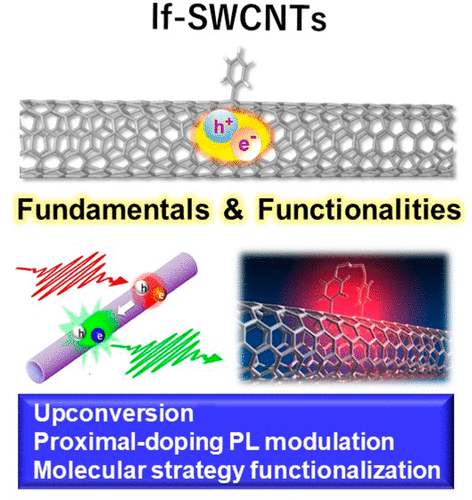当前位置:
X-MOL 学术
›
Acc. Chem. Res.
›
论文详情
Our official English website, www.x-mol.net, welcomes your
feedback! (Note: you will need to create a separate account there.)
Carbon Nanotube Photoluminescence Modulation by Local Chemical and Supramolecular Chemical Functionalization.
Accounts of Chemical Research ( IF 16.4 ) Pub Date : 2020-08-13 , DOI: 10.1021/acs.accounts.0c00294 Tomohiro Shiraki 1, 2 , Yuhei Miyauchi 3 , Kazunari Matsuda 3 , Naotoshi Nakashima 2
Accounts of Chemical Research ( IF 16.4 ) Pub Date : 2020-08-13 , DOI: 10.1021/acs.accounts.0c00294 Tomohiro Shiraki 1, 2 , Yuhei Miyauchi 3 , Kazunari Matsuda 3 , Naotoshi Nakashima 2
Affiliation

|
Carbon nanotubes (CNTs) have been central materials in nanoscience and nanotechnologies. Single-walled CNTs (SWCNTs) consisting of a cylindrical graphene show a metallic (met) or semiconducting (sc) property depending on their rolling up manner (chirality). The sc-SWCNTs show characteristic chirality-dependent optical properties of their absorption and photoluminescence (PL) in the near-infrared (NIR) region. These are derived from their highly π-conjugated structures having semiconducting crystalline sp2 carbon networks with defined nanoarchitectures that afford a strong quantum confinement and weak dielectric screening. Consequently, photoirradiation of the SWCNTs produces a stable and mobile exciton (excited electron–hole pair) even at room temperature, and the exciton properties dominate such optical phenomena in the SWCNTs. However, the mobile excitons decrease the PL efficiency due to nonradiative relaxation including collision with tube edges and relaxation to lower-lying dark states. A breakthrough regarding the efficient use of the mobile exciton for PL has recently been achieved by local chemical functionalization of the SWCNTs, in which the chemical reactions introduce local defects of oxygen and sp3 carbon atoms in the tube structures. The defect doping creates new emissive doped sites that have narrower band gaps and trap the mobile excitons, which provides locally functionalized SWCNTs (lf-SWCNTs). As a result, the localized exciton produces E11* PL with red-shifted wavelengths and enhanced PL quantum yields compared to the original E11 PL of the nonmodified SWCNTs.
中文翻译:

通过局部化学和超分子化学功能化对碳纳米管的光致发光进行调制。
碳纳米管(CNT)是纳米科学和纳米技术中的核心材料。取决于圆柱形石墨烯的单壁CNT(SWCNT)的卷起方式(手性)表现出金属(met)或半导体(sc)特性。sc-SWCNT在近红外(NIR)区域显示其吸收和光致发光(PL)的手征性相关光学特性。它们源自具有半导体晶体sp 2的高度π共轭结构具有定义的纳米结构的碳网络,可提供强的量子限制和弱的介电屏蔽。因此,即使在室温下,SWCNT的光辐照也会产生稳定且可移动的激子(激发的电子-空穴对),并且激子性质主导了SWCNT中的此类光学现象。然而,由于非辐射弛豫包括与管边缘的碰撞以及向较低处的暗态的弛豫,因此移动激子降低了PL效率。最近,通过对SWCNT进行局部化学官能化,实现了有效利用PL的移动激子方面的突破,其中化学反应引入了氧和sp 3的局部缺陷。管结构中的碳原子。缺陷掺杂产生了具有较窄的带隙并俘获了移动激子的新的发射掺杂位点,从而提供了局部功能化的SWCNT(lf-SWCNT)。结果,与未修饰的SWCNT的原始E 11 PL相比,局部激子产生具有红移波长的E 11 * PL和增强的PL量子产率。
更新日期:2020-09-15
中文翻译:

通过局部化学和超分子化学功能化对碳纳米管的光致发光进行调制。
碳纳米管(CNT)是纳米科学和纳米技术中的核心材料。取决于圆柱形石墨烯的单壁CNT(SWCNT)的卷起方式(手性)表现出金属(met)或半导体(sc)特性。sc-SWCNT在近红外(NIR)区域显示其吸收和光致发光(PL)的手征性相关光学特性。它们源自具有半导体晶体sp 2的高度π共轭结构具有定义的纳米结构的碳网络,可提供强的量子限制和弱的介电屏蔽。因此,即使在室温下,SWCNT的光辐照也会产生稳定且可移动的激子(激发的电子-空穴对),并且激子性质主导了SWCNT中的此类光学现象。然而,由于非辐射弛豫包括与管边缘的碰撞以及向较低处的暗态的弛豫,因此移动激子降低了PL效率。最近,通过对SWCNT进行局部化学官能化,实现了有效利用PL的移动激子方面的突破,其中化学反应引入了氧和sp 3的局部缺陷。管结构中的碳原子。缺陷掺杂产生了具有较窄的带隙并俘获了移动激子的新的发射掺杂位点,从而提供了局部功能化的SWCNT(lf-SWCNT)。结果,与未修饰的SWCNT的原始E 11 PL相比,局部激子产生具有红移波长的E 11 * PL和增强的PL量子产率。











































 京公网安备 11010802027423号
京公网安备 11010802027423号